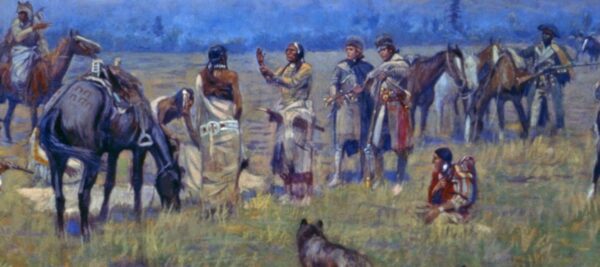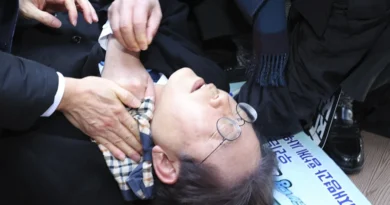‘Lewis and Clark Meet Salish Flathead Indians at Ross’s Hole’
Distressed Patriotic Flag Unisex T-Shirt - Celebrate Comfort and Country $11.29 USD Get it here>>

The explorers arrived in the valley on a cold and clear morning in September 1805. With a hint of winter coming, Meriwether Lewis wrote in his weather diary that an inch of ice covered the ground in Ross’s Hole, Montana. John Ordway, a member of the Lewis and Clark expedition, noted that snow now covered the nearby mountains. As the group descended the Bitterroot Mountains, second-in-command William Clark observed several ibex, or bighorn sheep, grazing nearby.
The Flathead peoples had lived in the valley between the Sapphire and Bitterroot mountain ranges of western Montana for many generations before the American explorers arrived. Clark writes how the explorers met lodge members of the Salish Flathead Indians and they were received warmly. Artist Charles Marion Russell (1864–1926) memorialized this meeting in his painting, “Lewis and Clark Meet With Salish Flathead Indians at Ross’s Hole” (1912).
Russell, known as the “Cowboy Artist,” made his home in Great Falls, Montana. Government officials commissioned the artist to do a painting for placement in the state’s legislative chamber in the capitol at Helena.
The artist was to paint “early Montana scenes and figures, as are of value from a historical standpoint, and that such decorations be executed by Montana Artists of recognized ability and standing,” which Senate joint Resolution No. 4, approved on Feb. 2, 1911. This was the first time Russell, who was self-taught, had attempted a painting of monumental scale. It was planned for the wall at the head of the chamber.
Go West, Young Man
Russell had honed his art skills and lived the life of a cowboy to prepare. The so-called Wild West, explored by the Lewis and Clark expedition less than 50 years before, obsessed young Charlie Russell growing up in St. Louis, Missouri, in the mid-1800s. He saw explorers and fur trappers come into his hometown and tell tales of their travels and watched as settlers left the Gateway City for land and opportunity.
He started drawing images of that fabled region at a young age, inspired by western pulp novels and the stories he heard.
He wanted to see the West for himself. When he was 16, Russell could no longer resist the call westward and left for Montana. He found work as a sheep herder, making sketches of the landscape as he worked. A rancher later hired him as a cowboy, where Russell documented the harsh winter in a series of watercolors.

He spent time among the Blood Indians, a part of the Blackfeet nation, learning their ways and collecting artifacts. Russell soon moved to Great Falls, Montana, where he began to make his living as an artist. He remained there for the rest of his life and memorialized his deep love for the West in a monumental painting.
Painting the Real West
The state of Montana was born with the yelps and cries of the original inhabitants who welcomed the explorers. Russell wanted to show this in his painting as a tribute to his adopted state’s vibrant ancestry.
A historical critique of the painting points to the dramatic story taking place: “The sweep of horses and Indian riders into the center foreground, the tilted lances, the dramatic cloud patterns, create an action scene of stupendous energy and vitality.” The significant, but less dramatic, negotiations between Lewis and Clark and the tribal leaders, on the other hand, are almost lost to view in the quiet of the middle ground on the right.

Russell places the Flathead warriors on horseback front and center, and now the painting comes alive. The graceful contortions of the young warriors immediately pull the viewer into the action. The composition stirs the imagination as the Indians are shown running forward at full speed, only to pull back at the last moment. The composition of this historic event shows the power and magnificence of the Salish lodge as their leader greets the expedition.
A description of the main figure notes: “Russell made numerous pencil sketches of the central figure in the painting until he arrived at the pose, the physical features, and above all, the telling gesture that would heighten the drama of this encounter. The expression on the [central Flathead Indian] face is severe, even fierce; the action is quick, vigorous, commanding.” The figure points to Lewis and Clark.
The far right of the composition shows the Salish lodge leader meeting with the explorers. The figures of Lewis and Clark, in contrast to the fierce stance of the Flathead warriors on horseback, are shown as patient and cautious as they await their guide’s translations.

According to recorded accounts, their Lemhi Shoshone guide, Toby, speaks to the Salish Flathead leaders in Plains sign language. Regarding the literal meaning of “Flathead,” most likely the name comes from a misinterpreted Indian sign made by patting the head above and back of the ear.
Sacagawea, another Lemhi Shoshone guide, is shown nearby kneeling in the grass; she was married to French Canadian fur trader Toussaint Charbonneau who was acting as the expedition’s guide across the Rocky Mountains.
William Clark’s slave York, another member of the expedition, tends the horses. The artist clothed York in more formal apparel of breeches and a tri-corner hat, instead of buckskins which he most likely would have worn during the expedition.
Although some criticized Russell’s inaccurate detail in Flathead dress, he used what was available to him at the time: notably, records in the Great Falls library, journals of the historic expedition, and his own extensive collection of native costume and artifacts.
Prickly Process Ends in Acclaim
Gov. Edwin L. Norris wanted the painting finished for the inauguration of the capitol, only months away. Russell’s wife, Nancy, often stepped in to allay the concerns of government officials that the painting would be finished in time, for she knew her husband; Russell worked with astonishing speed.
Russell’s painting was installed in the House of Representatives chambers ahead of schedule on July 11, 1912.

Although the interactions between the artist and state officials may have been bumpy at times, the end result satisfied all concerned. When the painting was unveiled, it was met by resounding praise.
Russell painted a grand scene, just as Renaissance artists depicted heavenly realms or historic events. The figures’ stance and movements tell the story, as good visual storytelling must do.
One reviewer from the Great Falls Daily Tribune wrote:
“If all the works of Russell, save this, were to perish, this picture would stand alone as a monument to his genius which would give him a leading place among America’s great artists.”
These western lands, newly mapped and recorded by Lewis and Clark, attracted artists wanting to live, admire, and paint its wild lands and peoples. Russell was one. He painted the scenes of this time and place while he lived them and used his artistic skills and imagination to bring the West alive for future generations.





